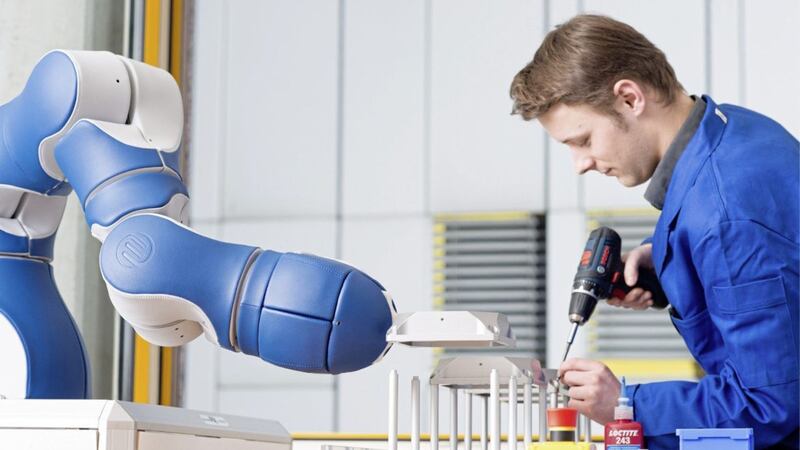RECENT developments in artificial intelligence, computer vision and motion-sensing capabilities, are creating a new generation of robots known as collaborative robotics, or “co-bots”.
In other words robots that can collaborate with humans on a factory floor, to help the company manufacture much more efficiently and develop its competitiveness and product profitability. As collaborative robotics become more and more common place, they’re having a distinctive impact on 'discrete manufacturing', especially for small and medium size manufacturers.
Companies that operate in such Industries as the car, furniture, toy, phone and aircraft industry use collaborative robotics to enhanced productivity, quality, and efficiency to improve profit margins.
Multiple sensors make it safe for collaborative robotics to work side-by-side with their human counterparts and many industry analysts are predicting a massive growth for collaborative robotics over the next decade especially in the average SME.
Robots have been in use since the likes of the Japanese car manufacturers introduced them back in the early 1960s. Assigned tasks that were repetitive, onerous, or dangerous, they have struggled to take on tasks requiring high precision and dexterity.
Robots were programmed to perform simple routine tasks on the factory floor, while the more complex and often random tasks, were left to humans.
One of the best known Achilles heels for manufacturing in this country and indeed most of Europe, is the issue of rising labour costs as a result, manufacturers need to find a way to reduce their labour costs, while increasing productivity.
Some experts are saying that collaborative robotics can boost productivity, with the same number of workers and in some cases, replace factory floor workers altogether.
Collaborative robotics boost productivity because they are not only cheaper and faster than the standard industry robots, but they’re also much smarter.
While industry robots are typically enclosed in a cage on the factory floor for safety to factory floor workers, collaborative robotics have many sensors and are made with the minimum of sharp cornered edges and often of softer materials.
The sensors are placed strategically to help prevent accidents or crushing incidents, making it safe for collaborative robotics to co-exist alongside humans on the factory floor. They are simply designed so as to insure human-robot collaboration.
Collaborative robotics also have what’s called force-limited joints which are designed to react quickly when an external force is sensed. With these type of joints, collaborative robotics have more “human” capabilities, like dexterity, memory, sensing, and trainability. This results in collaborative robotics being able to do more jobs, like testing, inspections, picking and packaging.
As collaborative robotics become more common place alongside humans, the SME manufacturing sector is set to revolutionise itself. Eventually low cost plug-and-play robotic tools, will find themselves more and more placed into the manufacturing process.
A recent study on human-machine productivity, conducted by MIT at a BMW factory, found that a team of humans and robots were more productive working together than either humans or robots working alone.
An increase in productivity leading to reduced downtime, has an immediate effect in lowering the bottom line costs for manufacturers.
PwC reports, from a worldwide perspective, that more than half of all SME manufacturers are currently using some form of robotics technology. These numbers are expected to jump in the coming decade, as smaller manufacturers rush to adopt collaborative robotics technology, and unlock new productivity pathways. Manufacturers that invest now in the next generation of robots, linked to their ERP systems, stand to gain a critical competitive edge.
Collaborative robots are equipped with far more sensors than their assembly line counterparts. These sensors generate constant data, that needs to be quickly transmitted to the cloud or their 'in-memory' ERP system, for instant processing and provide management with dynamic reporting to keep ahead of the competition.
:: Trevor Bingham (editorial@itfuel.com) is business relationship manager at ItFuel in Craigavon. Follow them on Twitter @itfuel








